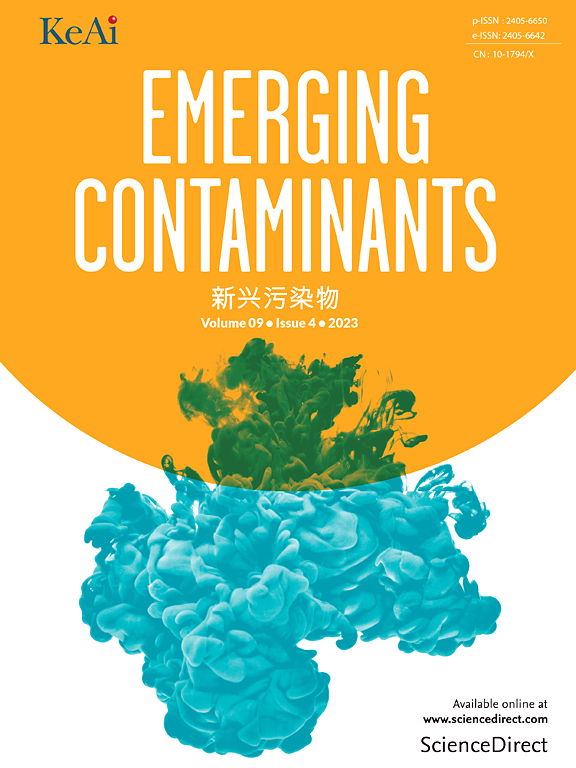盐渍环境中沉积物-微塑料非均质颗粒物(HPM)与镉的界面相互作用机制
IF 6.9
2区 环境科学与生态学
Q1 ENVIRONMENTAL SCIENCES
引用次数: 0
摘要
随着微塑料进入水生环境,目前尚不清楚非均质颗粒物(HPM,共存的沉积物和微塑料)与盐水中重金属之间的界面相互作用是否遵循与单一颗粒相同的机制,以及这些相互作用如何影响金属的流动性和生态风险。本研究阐明了不同盐度条件下HPM与镉(Cd)之间的界面机制,强调了微塑料在HPM中的关键作用。结果表明:(1)5 PSU和15 PSU是影响界面相互作用的关键盐度阈值,低盐度(<5 PSU)增强了表面性能,促进了快速的初始吸附(0-30 min),但保留有限,而高盐度(>15 PSU)显著抑制了Cd的吸附;(2)微塑料通过改变界面相互作用,增加了水体系统的盐度敏感性,增强了抑制效果,在7.5 PSU时最大抑制率(IR = 41.29%);(3)盐度影响函数(Fs)根据盐度散度系数(SDC)准确表征了盐度效应和微塑料对HPM吸附Cd的贡献(R2 = 0.92),支持重金属命运的可靠预测。这些发现为重金属在受盐影响的水生环境中的迁移提供了理论见解。本文章由计算机程序翻译,如有差异,请以英文原文为准。

Interfacial interaction mechanisms between sediment-microplastics heterogeneous particulate matter (HPM) and cadmium (Cd) in saline environment
As microplastics enter aquatic environments, it remains unclear whether interfacial interactions between heterogeneous particulate matter (HPM, co-existing sediment and microplastics) and heavy metals in saline waters follow the same mechanisms as single particles, and how these interactions affect metal mobility and ecological risk. This study elucidates the interfacial mechanisms between HPM and cadmium (Cd) under various salinity conditions, highlighting the critical role of microplastics within HPM. Results show that: (1) 5 PSU and 15 PSU serve as critical salinity thresholds influencing interfacial interactions–low salinity (<5 PSU) enhances surface properties, promoting rapid initial adsorption (0–30 min) but limited retention, whereas high salinity (>15 PSU) significantly inhibits Cd adsorption; (2) Microplastics increase the salinity sensitivity of aquatic systems by modifying interfacial interaction to enhance the inhibitory effect, with maximum inhibition rate (IR = 41.29 %) observed at 7.5 PSU; (3) Salinity influence function (Fs), according to the salinity divergence coefficient (SDC), accurately characterizes the salinity effect and the microplastics contribution to Cd adsorption on HPM (R2 = 0.92), supporting robust predictors of heavy metal fate. These findings offer theoretical insight into heavy metal transport in salt-affected aquatic environments.
求助全文
通过发布文献求助,成功后即可免费获取论文全文。
去求助
来源期刊

Emerging Contaminants
Medicine-Public Health, Environmental and Occupational Health
CiteScore
10.00
自引率
6.70%
发文量
35
审稿时长
44 days
期刊介绍:
Emerging Contaminants is an outlet for world-leading research addressing problems associated with environmental contamination caused by emerging contaminants and their solutions. Emerging contaminants are defined as chemicals that are not currently (or have been only recently) regulated and about which there exist concerns regarding their impact on human or ecological health. Examples of emerging contaminants include disinfection by-products, pharmaceutical and personal care products, persistent organic chemicals, and mercury etc. as well as their degradation products. We encourage papers addressing science that facilitates greater understanding of the nature, extent, and impacts of the presence of emerging contaminants in the environment; technology that exploits original principles to reduce and control their environmental presence; as well as the development, implementation and efficacy of national and international policies to protect human health and the environment from emerging contaminants.
 求助内容:
求助内容: 应助结果提醒方式:
应助结果提醒方式:


